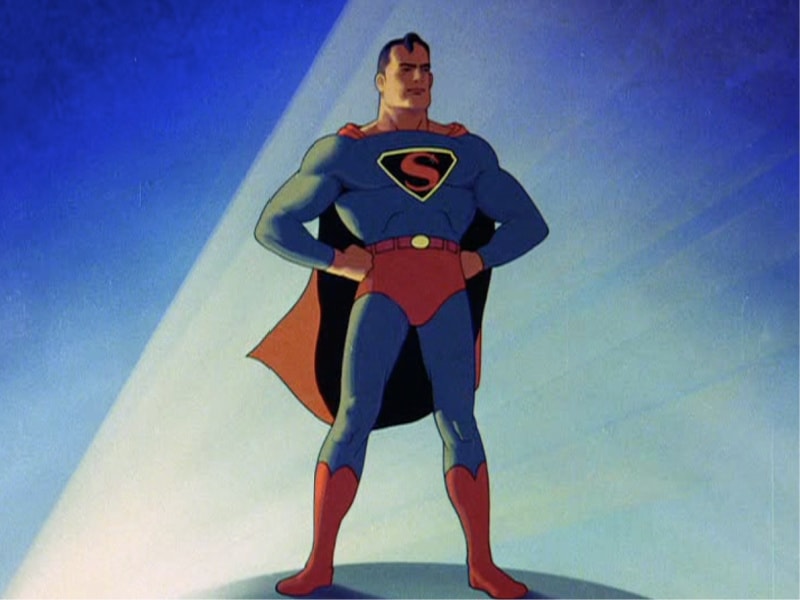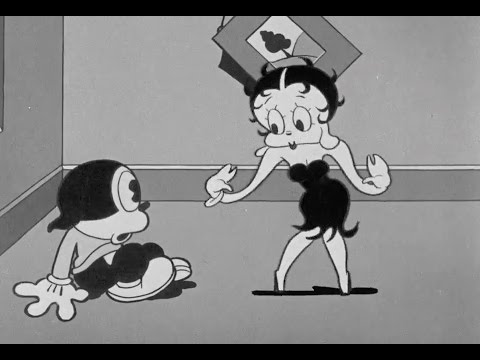RE:Animation – Superman (1940)

UPDATED (12/7/23): Just skip to the bottom if you’ve read this one before.
Welcome to the start of my new series of retrospectives on classic superhero animated productions here at Arkhaven Blog. And I am beginning with the granddaddy of them all. Superman (1941).
The animation quality of the 1940s Superman animated serials has never been equaled since. The art design was a deco vision whose colors were both vivacious while being subtly layered and vibrant. The character movement was analog realistic. There was nothing it didn’t get right. And no one has come close to recreating its level of artwork in a superhero cartoon since.
In the two years between the publication of Action Comics #1 and 1940, Superman became an unmatched national phenomenon. His comics sold in the millions (seriously, they did). He had his own radio show. A giant balloon Superman floated over the Macy’s parade in New York. And movie studios decided it was time to get into the cartoon superhero business.
Republic Studios got ahold of the rights at first, but negotiations with National Comics (soon to be renamed DC Comics) broke down. It was Paramount’s turn after that, and they had the advantage of owning controlling interest in the number two animation studio in the business right behind Disney. Fleischer Studios. And Fleischer Studios came with Max Fleischer himself.
By 1940 Max Fleischer was at something of a crossroads in life.
At the age of three, he immigrated from Poland to the USA. His family lived in one of the Jewish “ghettos” of Brooklyn. He did the usual budding artist thing of sketching constantly, in fact, his brother David joined him in this. He wanted to make a living as an artist, but his family insisted that he learn a trade. While the immigrant Fleischer family was willing to pay for high school (not free in those days) he had to attend the Mechanics and Tradesman’s School in mid-town Manhatten. He was however allowed to continue his art training at the Art Students League of New York.
It turned out that combining these two educations served Max Fleischer surprisingly well.
He got a job as a sketch artist for Popular Science and began to explore his budding interest in photography. He also began work at the Brooklyn Daily Eagle. He worked his way up to doing his first comic strip; Little Algie.
Max’s interest in mechanics, art, and photography were all combined when he invented and patented the roto-scope. The principle was simple enough, you used it to make a sketch of an actor that had been filmed in live-action, and after you had the movement down you filled in the artwork and color.
The nickelodeons weren’t that picky about content yet so he was able to sell his experiments with the rotoscope as the Out of Inkwell series.
The Fleischer Brothers’ first really big success was with their wholly-owned Betty Boop.

No, I don’t get the attraction either, but she was a superstar in her day. For some reason, this 1920s flapper really spoke to 1930s America. Their other big success was in licensing Popeye. Things were going pretty well for them, but trouble was on the horizon. Another pair of brothers from the Midwest and their talking mouse cartoons were starting to nip at the heels of Fleischer Studios. Although it was Max Fleischer, not Walt Disney that first combined sound with animation.
In 1934 Max Fleischer began trying to sell an odd little passion project to (his senior partner), Paramount Pictures, Gulliver’s Travels. It was to be a feature-length cartoon and it earned him a hasty, “no thanks.” Even after he tried reworking it as a Popeye movie the answer remained an emphatic, NO.
But then Disney’s massive success with Snow White instantly changed the studio’s mind. Gulliver was released a mere eighteen months after Snow White and I’m afraid it shows. It wasn’t terrible, it just wasn’t as good as Walt Disney’s film. It could honestly be said to be something of a classic, and I was surprised to find out that Paramount had let it slip into the public domain. But the film was definitely rushed and it showed.
Max and Dave Fleischer were in their mid-fifties by 1940, considering the average life expectancy was 63 at the time, they had to feel there was a lot less road in front of them than behind them. They were being left behind by Disney Studios and Termite Terrace was nipping at their heels. This kind of thing tends to make old men more cautious, there is a lot less time to make up for big mistakes that late in the game. They were trying not to slip into third place and had a lot more interest in hanging on to what they had than in regaining past glory.
So, when Paramount came to them with the chance to be, “the very first studio to produce a superhero cartoon,” they were cold to the idea. They went from cold to completely uninterested when they found out that the deal Paramount had inked left them with no merchandising residuals and National Comics had the right of veto on everything.
The view of the brothers was, well we don’t want to do this thing but we can’t turn down Paramount cold. They are our senior partners. But what we can do is highball the hell out of them and let them do the walking away from the deal. We’re in the clear that way.
Fleischer Studios came back to the table with, “$100,000 per episode. Take it or leave it.” That was about, 1,800,000 in 1940 dollars and it was completely nuts.
To Max’s shock, Paramount countered with, “How about $50,000?” Which was still an absurdly high amount. Sure it was stupid money but Max discovered he had a price after all and that was it. Superman, the cartoon serial was happening.
At that point, he had to start looking over the problems involved with the production. The biggest was rotoscoping Superman with the technology available. The animated movement was smooth, but the edges tended to be rough. You were tracing after all. It was easy to clean up if you put your characters in bulky medieval costumes but so far as the animation was concerned, his skintight outfit made Superman a heroic nude.
Another issue was Superman’s “leaping tall buildings in a single bound.” The Last Son of Krypton was still operating off of his original rules back then. He could jump twenty-five miles and it took an artillery shell to pierce his skin. But Kryptonite and the rest were a ways off yet. The problem for Fleischer was he just couldn’t make the jumps look good. He finally asked National Comics, “Look, can I just make him fly?” National Comics agreed.
These issues were challenging but not insurmountable, and Max began to feel the kind of engagement with a project that he hadn’t for years.
In addition, Superman appealed to Max Fleischer’s love of science fiction and mechanics. These cartoons always showcased these elements.
No denying it was a major success for Paramount and Fleischer Studios. People were coming to the theaters just to watch the Superman serials and that was not what they were supposed to do. The serials were just filler before the feature, not the feature itself.
These shorts got the Fleischers their first Oscar nomination
Superman also gave Max Fleischer a more mature subject matter that he hadn’t been allowed to explore up to that time. It’s a little hard to believe on an emotional level but there was indeed a time when the Man of Tomorrow was a brand new character. Max Fleisher added quite a lot to the tropes that we associate with Superman. Max was one of this character’s most important influences because he was the first man to make Superman alive. These cartoons made supple this character’s limbs, breathed life into his lungs, and gave him free movement before people’s eyes. It made him real and also his world. It did so in a way that no comic book could match. A lot of what we think of when we think of Superman began at Fleischer Studios.
The animation is still arresting eighty years later. This world is a 1930 high-tech, art deco dream with machinery, aircraft, and weapons that leaped off the cover of Astounding Tales. The rotoscope animation was as smooth as 1940 could make it, and the color palette was complex and gorgeous. These shorts deserve the praise they are still getting after all these decades.
It was a major late-in-life win for Max Fleischer.
Sadly, the success of Superman led to his downfall.
Max Fleischer’s next project was, Mister Bug Goes to Town. It was technically superior to Gulliver’s Travels, but it was drastically more expensive with a budget of $1 million. It would be the last animated feature that Paramount would release until Charlotte’s Web (1973). There was a reason for that.
Part of the expense was a breakdown in the relationship of the Fleischer brothers. The failure of Gulliver’s Travels had led to a major falling out. They couldn’t speak to each other by 1941 and managing a studio by means of terse and abusive notes flying back and forth was as much comedy as it was a tragedy.
However, Mister Bug’s biggest problem was its release date; December 5th, 1941. After Pearl Harbor, none of the theaters were willing to touch an absurd, feel-good movie. NONE.
Max Fleischer was called to New York and his resignation was demanded.
Fleischer Studios became Famous Studios, Superman’s budget was slashed to the bone and the blue-clad Kryptonian spent the remainder of his contract punching Nazis. The Fleischer Superman shorts are all in the public domain, which is a pity because that means no one has a motive to restore them.*
Superman wouldn’t be animated again until Filmation started the Adventures of the Superman in the mid-sixties. The quality was on par with Scooby Doo’s.
When Max Fleischer’s son, Richard was directing 20,000 Leagues Under the Sea, the father visited the son for lunch. Richard invited his boss Walt Disney to join them. The lunch was quite cordial with Max stating he was happy to be making education cartoons at this late time of his life.
After lunch broke up Walt remarked to Richard that his father was a quite genial and affable gentleman.
Richard Fleisher replied, that his father couldn’t say the name Disney without adding, “That son of a bitch.”
*Yeah, about that. Warner Brothers actually restored and remastered it as 4K. This was apparently one of James Gunn’s initiatives.

